The 9th SHARP Progress meeting took place on 17th March, 2023.
News
New Publication: “X-Ray Polarimetry Reveals the Magnetic-field Topology on Sub-parsec Scales in Tycho’s Supernova Remnant” by Riccardo Ferrazzoli et al.
Supernova remnants are commonly considered to produce most of the Galactic cosmic rays via diffusive shock acceleration. However, many questions regarding the physical conditions at shock fronts, such as the magnetic-field morphology close to the particle acceleration sites, remain open. Here we report the detection of a localized polarization signal from some synchrotron X-ray emitting regions of Tycho’s supernova remnant made by the Imaging X-ray Polarimetry Explorer. The derived degree of polarization of the X-ray synchrotron emission is 9% ± 2% averaged over the whole remnant, and 12% ± 2% at the rim, higher than the value of polarization of 7%–8% observed in the radio band. In the west region, the degree of polarization is 23% ± 4%. The degree of X-ray polarization in Tycho is higher than for Cassiopeia A, suggesting a more ordered magnetic field or a larger maximum turbulence scale. The measured tangential direction of polarization corresponds to the radial magnetic field, and is consistent with that observed in the radio band. These results are compatible with the expectation of turbulence produced by an anisotropic cascade of a radial magnetic field near the shock, where we derive a magnetic-field amplification factor of 3.4 ± 0.3. The fact that this value is significantly smaller than those expected from acceleration models is indicative of highly anisotropic magnetic-field turbulence, or that the emitting electrons either favor regions of lower turbulence, or accumulate close to where the orientation of the magnetic field is preferentially radially oriented due to hydrodynamical instabilities.
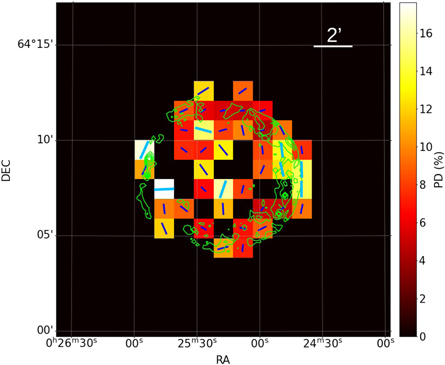
Full Article:
Ferrazzoli, R., Slane, P., Prokhorov, D. (SHARP), Zhou, P., Vink, J. (SHARP), et al. (2023). X-Ray Polarimetry Reveals the Magnetic-field Topology on Sub-parsec Scales in Tycho’s Supernova Remnant. The Astrophysical Journal, 945, doi: 10.3847/1538-4357/acb496
License: CC BY 4.0
New Publication: “Shock Heating of Incident Thermal and Superthermal Populations of Different Ion Species” by Michael Gedalin et al.
Using ion tracing in a model shock front we study heating of thermal (Maxwellian) and superthermal (Vasyliunas–Siscoe) populations of protons, singly charged helium, and alpha particles. It is found that heating of thermal and superthermal populations is different, mainly because of substantially higher ion reflection in the superthermal populations. Accordingly, the temperature increase of initially superthermal populations is substantially higher than that of the thermal ions. Heating per mass decreases with the increase of the mass-to-charge ratio because of the reduced effect of the cross-shock potential and, accordingly, weaker ion reflection. The findings are supported by two-dimensional hybrid simulations.
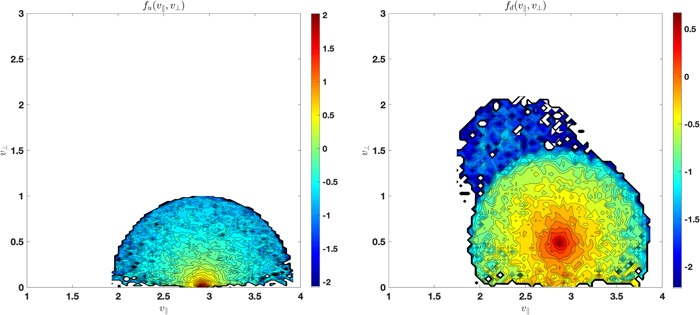
Full Article:
Gedalin, M. (SHARP), Roytershteyn, V., Pogorelov, N. V. (2023). Shock Heating of Incident Thermal and Superthermal Populations of Different Ion Species. The Astrophysical Journal, 945, doi: 10.3847/1538-4357/acb13a
License: CC BY 4.0
Collisionless shock meeting
As part of the SHARP project, the Swedish Institute for Space Physics (IRF) organised a Collisionless shock meeting on January 26-27th in Uppsala, Sweden. The meeting consisted of sessions on interplanetary shocks, astrophysical shocks, foreshock/sheath plasma regions and planetary bow shocks. The program is available here.
SHARP Review meeting
The second SHARP Review meeting took place on January 24th and 25th, 2023.
New Publication: “Electron Heating Scales in Collisionless Shocks Measured by MMS” by Andreas Johlander at al.
Electron heating at collisionless shocks in space is a combination of adiabatic heating due to large-scale electric and magnetic fields and non-adiabatic scattering by high-frequency fluctuations. The scales at which heating happens hints to what physical processes are taking place. In this letter, we study electron heating scales with data from the Magnetospheric Multiscale (MMS) spacecraft at Earth’s quasi-perpendicular bow shock. We utilize the tight tetrahedron formation and high-resolution plasma measurements of MMS to directly measure the electron temperature gradient. From this, we reconstruct the electron temperature profile inside the shock ramp and find that the electron temperature increase takes place on ion or sub-ion scales. Further, we use Liouville mapping to investigate the electron distributions through the ramp to estimate the deHoffmann-Teller potential and electric field. We find that electron heating is highly non-adiabatic at the high-Mach number shocks studied here.
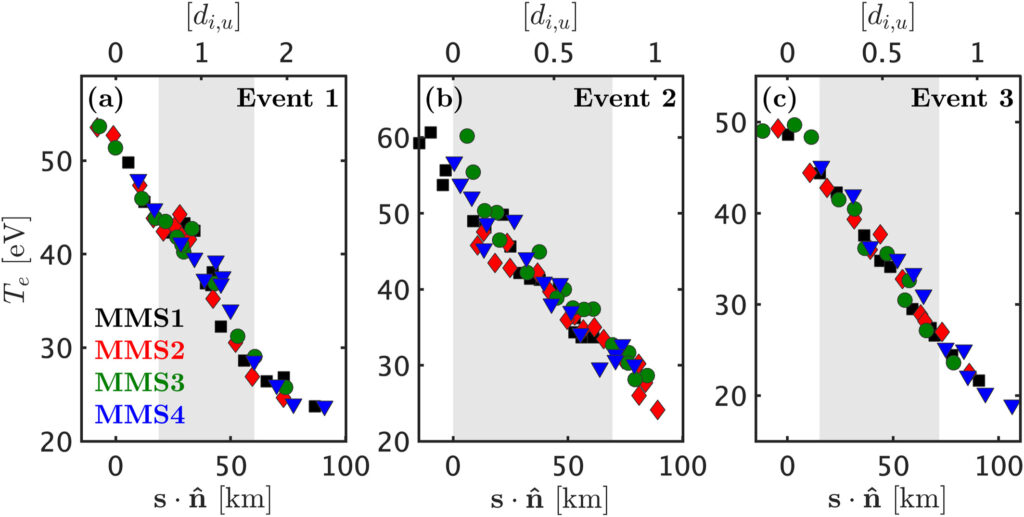
 which means that upstream is at higher values regardless of which direction the spacecraft crossed the shock. Units are km on the bottom and di,u on the top. The shortest distance where half the temperature increase takes place is marked in gray.
which means that upstream is at higher values regardless of which direction the spacecraft crossed the shock. Units are km on the bottom and di,u on the top. The shortest distance where half the temperature increase takes place is marked in gray.Full Article:
Johlander, A. (SHARP), Khotyaintsev, Y. V. (SHARP), Dimmock, A. P. (SHARP), Graham, D. B. (SHARP), & Lalti, A. (SHARP) (2023). Electron heating scales in collisionless shocks measured by MMS. Geophysical Research Letters, 50, doi: 10.1029/2022GL100400
License: CC BY 4.0
New Publication: “Transmission of foreshock waves through Earth’s bow shock” by Lucile Turc et al.
The Earth’s magnetosphere and its bow shock, which is formed by the interaction of the supersonic solar wind with the terrestrial magnetic field, constitute a rich natural laboratory enabling in situ investigations of universal plasma processes. Under suitable interplanetary magnetic field conditions, a foreshock with intense wave activity forms upstream of the bow shock. So-called 30 s waves, named after their typical period at Earth, are the dominant wave mode in the foreshock and play an important role in modulating the shape of the shock front and affect particle reflection at the shock. These waves are also observed inside the magnetosphere and down to the Earth’s surface, but how they are transmitted through the bow shock remains unknown. By combining state-of-the-art global numerical simulations and spacecraft observations, we demonstrate that the interaction of foreshock waves with the shock generates earthward-propagating, fast-mode waves, which reach the magnetosphere. These findings give crucial insight into the interaction of waves with collisionless shocks in general and their impact on the downstream medium.
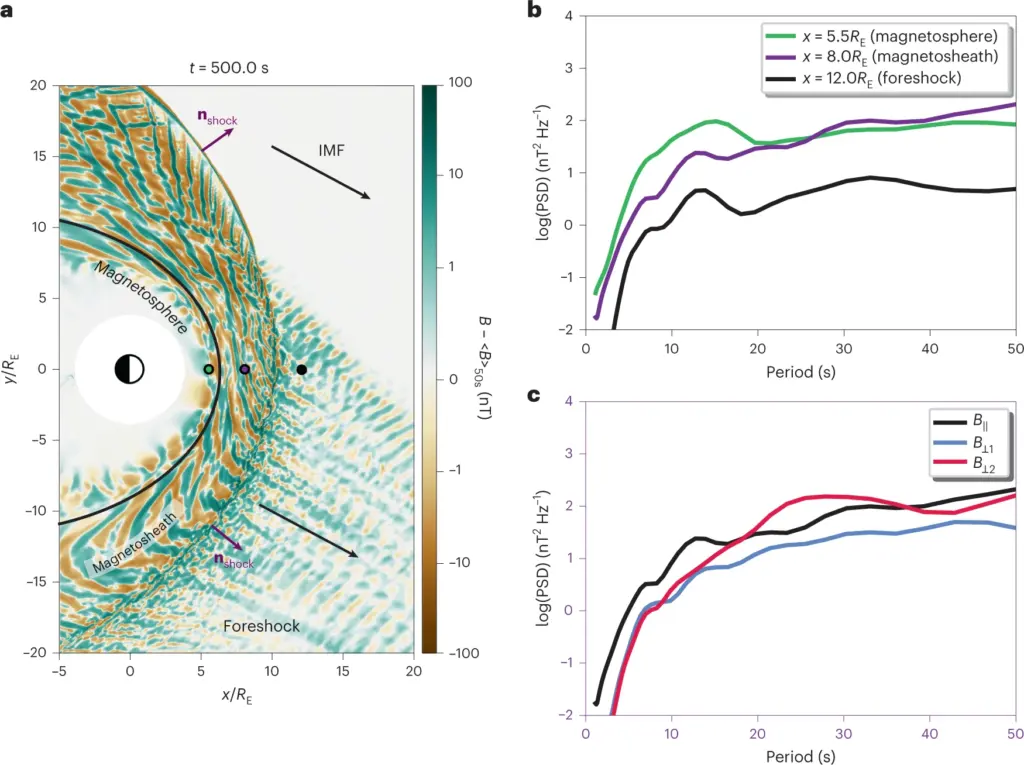
Full Article:
Turc, L., Roberts, O.W., Verscharen, D., Dimmock, A. P. (SHARP) et al. (2022). Transmission of foreshock waves through Earth’s bow shock. Nature Physics, 19, doi: 10.1038/s41567-022-01837-z
License: CC BY 4.0
SHARPENTINE Kick-off meeting
SHARPENTINE Kick-off meeting took place on December 7th, 2022. The meetings are meant to strengthen the collaboration and interaction between the SHARP and SERPENTINE projects.
SHARP Working meeting
SHARP Working meeting on the future synthesis of heliospheric and astrophysical shocks with participation of colleagues from SERPENTINE project was held on December 1st, 2022.
New Publication: “An update on Fermi-LAT transients in the Galactic plane, including strong activity of Cygnus X-3 in mid-2020” by Dmitry Prokhorov et al.
We present a search for Galactic transient γ-ray sources using 13 yr of the Fermi Large Area Telescope data. The search is based on a recently developed variable-size sliding-time-window (VSSTW) analysis and aimed at studying variable γ-ray emission from binary systems, including novae, γ-ray binaries, and microquasars. Compared to the previous search for transient sources at random positions in the sky with 11.5 yr of data, we included γ-rays with energies down to 500 MeV, increased a number of test positions, and extended the data set by adding data collected between 2020 February and 2021 July. These refinements allowed us to detect additional three novae, V1324 Sco, V5855 Sgr, V357 Mus, and one γ-ray binary, PSR B1259-63, with the VSSTW method. Our search revealed a γ-ray flare from the microquasar, Cygnus X-3, occurred in 2020. When applied to equal quarters of the data, the analysis provided us with detections of repeating signals from PSR B1259-63, LS I +61°303, PSR J2021+4026, and Cygnus X-3. While the Cygnus X-3 was bright in γ-rays in mid-2020, it was in a soft X-ray state and we found that its γ-ray emission was modulated with the orbital period.
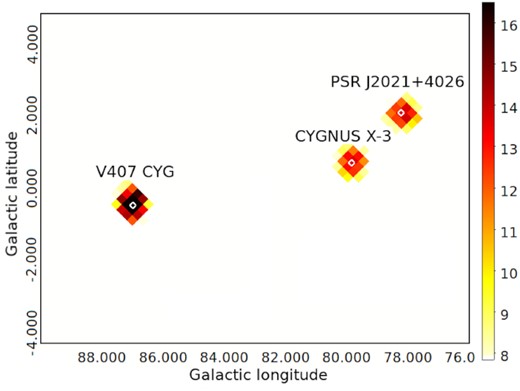
Full Article:
Prokhorov, D. A. (SHARP), Moraghan, A. (2022). An update on Fermi-LAT transients in the Galactic plane, including strong activity of Cygnus X-3 in mid-2020. Monthly Notices of the Royal Astronomical Society, 519, doi: 10.1093/mnras/stac3453
License: CC BY 4.0





